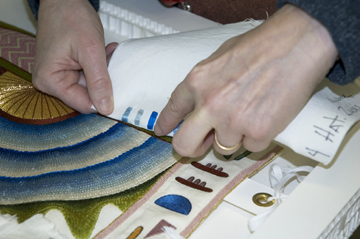Preservation History
A History of Preservation
The Dinner Party's preservation efforts began with its construction. Judy Chicago and the many artisans and needleworkers who helped her create The Dinner Party made every effort to choose the most stable materials possible. Before being incorporated in the work, proposed samples of textiles and threads were often tested for color fastness, for shrinkage or distortion, and for changes to surface quality.

The needleworkers kept records, which included copious notes about the construction of many of the runners, the threads and fabrics used, and the results of cleaning tests. Included in these records are mock-ups and samples of materials and threads used in many of the place setting runners. These workshop records are archived at the Brooklyn Museum and are an invaluable resource for the Museum's long-term preservation of The Dinner Party.

Notebooks with labeled covers
In 1996, in preparation for an installation in Los Angeles, the textile portion of The Dinner Party (the 39 place setting runners, the Millennium runners, the tablecloths, and the Entry Banners) received conservation treatment. In 1997, with a grant from the Getty Grant Program, a team of conservators with specialties in paper, photographs, paintings, objects, and textiles examined the components of the entire Dinner Party. The resulting survey report of 8 notebooks provides a technical description of all the components, their existing conditions, and recommendations for treatments.

Woman comparing color swatches to runner embroidery
In 2002, the Conservation Department of the Brooklyn Museum, having received the archive material as well as the Getty Conservation Survey, also examined and documented the condition of The Dinner Party and issued proposals for the installation environment and future treatment needs. In preparation for the long-term installation, the Museum undertook a treatment program to stabilize and clean all the textiles and ceramics. The textiles were cleaned with vacuums and special attachments to remove ingrained soiling. Existing thread and fabric samples from the archived records were compared against each of the original runners. There appears to be no apparent difference between the two, indicating little color change in most of the works.

Woman cleaning a ceramic plate
The ceramic elements (Heritage Floor tiles, the utensils, the chalices, and the plates), which are subject to changes in condition from handling and dust, were treated and cleaned. For this installation, consolidation (the re-securing of paint or glazes to their support) was undertaken for some of the plates. Most of the details on the plates are applied using overglaze enamels, made from low-fire glazes, whereas some of the details are made using paint. Both are liable to flake off the ceramic surface.
Read more about the environmental factors that were considered when planning the new exhibition.